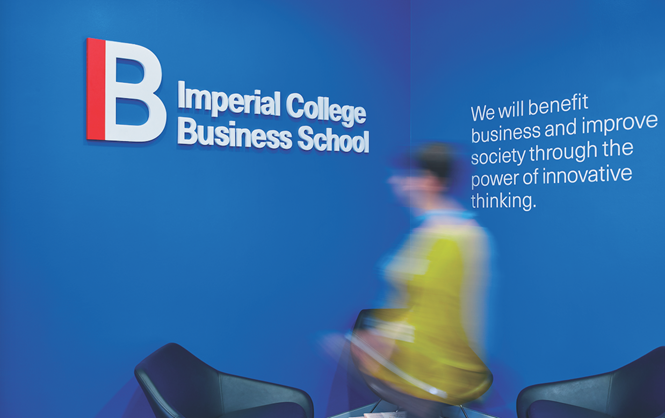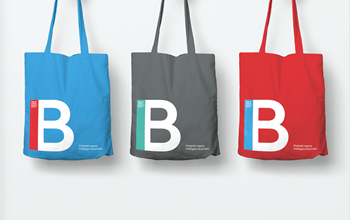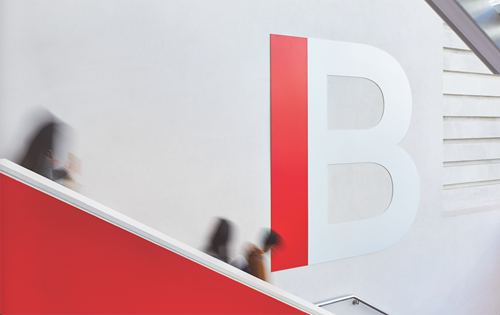Spotlight on Imperial College Business School

With a long history and the need to differentiate itself, the Imperial College Business School set out a new brand strategy that positions it as a modern, elite institution for entrepreneurial thinking. Amy Sandys reports
Almost exactly 130 years ago, in 1887, a widowed Queen Victoria laid the foundation stone for the educational centre known as the Imperial Institute, later Imperial College London. Coinciding with the queen’s jubilee celebrations, the construction of a network of modern laboratories, lecture theatres and university buildings was another step towards the late Prince Albert’s vision of establishing an area of culture and education in South Kensington, London. Along with, among others, the Victoria and Albert Museum, the Natural History Museum and the Royal Albert Hall, Imperial College London became integrated into the famous ‘Albertopolis,’ a homage to Prince Albert’s belief in gifting the people of London with institutions of art and education.
Built with funds procured from the Great Exhibition, the world’s first showcase of manufactured goods, ‘Albertopolis’ still straddles the boroughs of Westminster, and Kensington and Chelsea. Albert’s lifetime was confined only to the 19th century, but the German prince’s civic-minded creativity extends beyond the bricks comprising the famous institutions showcased along Exhibition Road. Indeed, for Imperial College London, communicating the ideas which constitute societal advancement is confined not only to the classroom.
A leader in science, technology and engineering, the Imperial College London consistently places among the best in world rankings and, in keeping with the mindset of its proprietor, offers a decidedly broad spectrum of subjects. For Imperial College London’s business school, Imperial College Business School (known as Imperial Business, or IB), a launch in the 1960s and ongoing maturation over the late 20th century is bound up with the university’s future-facing approach to academia.
A recent rebrand, whereby the business school has adopted a communications-driven brand strategy to attract top academic talent, mirrors Prince Albert’s determination in its aim to provide academic courses applicable to a changing world. “One of the things that’s really important to us, and the vision of the college, is the vision of Prince Albert who helped establish this whole precinct,” says Tim Ruthven, head of marketing and communications at IB. “His vision was to develop an institution that benefits business and society. Bringing in the arts, science and industry together to perform as an innovation hub – that’s what makes Imperial special.”
And special Imperial College Business School is. While its transition, from a six-person sub-department in the mid-1960s to a leading UK school for national and international business students has cemented its place in the lexicon of future entrepreneurs, the need for a visual and strategic brand update stemmed from a lack of differentiation between the school and its competitors. Despite Imperial College Business School’s longevity in the still-recent field of business studies, before the rebrand, awareness of its unique approach to global shift was low. Future plans for the business school surpassed its current lacklustre and generic mission statement, ‘Research and teaching for the benefit of business and society.’ A priority was deciding how to showcase Imperial College Business School’s distinct identity. “It was much more than how we were perceived in the UK, Europe or globally,” Ruthven says. “Really, it was identifying that we needed to decide ourselves who we were and what value we were offering our stakeholders before we started communicating it. It was also making sure that the value we were communicating to the stakeholders was actually of interest of them.”
This meant IB did not rely on a purely visual makeover to achieve its goals of recruiting more students and raising brand awareness among a melee of competing institutions, says Ruthven.
Max du Bois, executive director at London-based graphic design agency Spencer du Bois who was integral in shaping the Imperial College Business School brand strategy, agrees. To ensure sustained visibility in the rapidly changing global city of London, while retaining its valuable links with Imperial College London, emphasis was needed on what marks IB apart from other business-oriented institutions.

“The brand identity was very much about how we could give IB that stand out simple identity that allowed them to use it as a lens, how it could show that fusion of business and technology creatively”
Stakeholder feedback pointed to the IB’s relative obscurity, arguably due to a lack of differentiation from the clearer and more visible Imperial College London brand. Yet, du Bois explains, the tendency for business schools to rely on uninspiring visual identities and generic brand positioning also led to a stagnation in IB’s unique offering. “The issue Imperial College Business School had was a lot of people didn’t know it had a business school. And because Imperial does a lot of entrepreneurs and not so many people in-house, its league table position doesn’t put it up where it belongs.” This, says du Bois, meant the rebrand strategy focused on showcasing the best the university had to offer.
“Imperial was doing a very good job of marketing itself, but it wasn’t differentiating itself from saying, ‘What’s our special magic? Why come to us, rather than anywhere else?’” And, as Ruthven explains, what could have provided the business school’s downfall also proves its greatest differentiator. “The biggest strength that Imperial College Business School has is that its part of Imperial College London and that brings us a lot of benefits in terms of making it distinct in the market. With significant strengths in science, engineering, business and medicine, bringing together that fusion of business and tech is what we consider to be our distinctive attribute.” Clarifying the school’s message also meant implementing visual changes. For Frances Jackson, CEO and client director at London-based branding studio OPX, the unique educational environment which fosters IB allowed OPX to develop the school’s new identity from the inside out.
Jackson says, “When we develop a brand, we are developing a brand for the world we live in now.” For the team at OPX, the modern nature of IB’s work as well as the universal need for universities to attract new stakeholders meant accounting for the varying contexts of a changing IB brand. Jackson says, “That essentially means being aware of how it works across every single channel and being aware of how it works where you can’t control it as well. Thinking about the brand in the context of how it might appear on social, to how it might appear in an environment, to how it might behave with digital interaction.”
However, one aspect of the new Imperial College Business School brand implementation relied on a mode of transport almost as old as the university itself – the London Underground. With its canonical and somewhat risqué ‘How the future’ tagline, Jackson explains, IB could go beyond the language of business schools which tend to stick to similar, rather cliched, tropes. Instead, applying ‘How the future’ to a follow-on question – for example, ‘How the future can business improve society?’ – immediately creates a link between IB and wider society.
“The whole language piece is about reinforcing [Imperial’s] attributes in terms of inspiring brilliant minds and the fusion of business and technology,” says Jackson. “But the brand identity, when we developed it, was very much about how we could give [IB] that stand out simple identity that allowed them to use it as a lens, how it could show that fusion of business and technology creatively – but also had something very distinctive that gave them the chance to stand out.” For both du Bois and Jackson, the key to a successful academic rebrand lay in the use of language to attract a new audience to the IB offering – and where better to apply this than in one of the busiest, most international transportation systems.
By highlighting grassroots feeling and emphasising how IB relied on more than just Imperial’s brand reputation, from co-creation emerged a strategy strong enough to detach IB from its parent brand. A bottom-up, community-led brand consolidation became the crux of the project’s strategy and led to the innovative brand plan, leading to the school quadrupling in size and functioning at full capacity.
To develop a rebrand that delivered on its takeholder promise, differentiation – apart from the business school’s association with Imperial College London – was needed. Learning from its colourful past, with its integration into Albertopolis, Imperial College Business School’s origins in the university science department inform its approach to teaching and learning business strategy. A holistic approach to learning, combining science and technology with business studies to create fresh approaches to societal issues, has seen IB become an institution fit to tackle to modern business challenges. As business integrates into all aspects of society, so too is it understood in the context of the seismic political, environmental and economic shifts that continue to shape the world.
Ruthven says such self-awareness sees Imperial’s reach extend far beyond traditional business attributes of stock control and profit generation. “If you think about the fusion of business and tech, we’re talking about how tech is driving changes in the financial services, how it’s driving changes in business with data, how technology is helping in operations research and helping managers make more informed decisions based on good analytics.” Not only does such a forward-thinking approach set IB apart in terms of brand offering; it also demonstrates how the excellent academic record enjoyed by Imperial College London is filtering throughout its sub-departments.
Again, says du Bois, language is integral in communicating IB’s brand promise. “When we say ‘Imperial means intelligent business’ [the business school’s strapline], we want to say two things,” he says. “First, we look at things more deeply, more quickly, more profoundly; our courses are far more savvy.” And the association of IB with science and technology also impacts, positively, the meaning of its strapline – essentially, its brand offering – is unique among its competitors. Du Bois adds, “What we wanted to say was a lot of other business schools are not about intelligent business.” It is Imperial’s global outlook, as envisaged by Prince Albert back in the mid-19th century, which lends the business school enough credibility to compete with global institutions such as Oxford’s Saïd Business School or Harvard. “Imperial is about pioneering novel solutions to global challenges,” Ruthven says.
And, after extensive stakeholder engagement and meticulous attention to detail, pursuing co-creation and risqué advertising strategies, Imperial College’s business prowess shines. Perhaps the continued success of Imperial College Business School hinges on Prince Albert’s vision to combine the sciences and culture into one clear vision. However, its rebrand depended on allowing its many passionate advocates to have a voice.
Peer reviews

Gary Wheat, brand director, Studio Jo+Co
I must lay my cards on the table from the outset and say I am a huge fan of the Imperial College branding. It has a robust simplicity which enables real ease of use and application. The colour palette and variant applications all work hard to navigate the design minefield that separates ‘differentiation’ and ‘garish’- those two sworn enemies that all too often join forces to ruin a rebrand, refresh or repositioning.
The agencies involved should be applauded for taking inspiration from the world into which the Imperial students will aspire to be influential figures within- that of contemporary commerce and business. It is an oft used approach in the education sector to fall back on heritage and motto’s, something Imperial College has thankfully avoided, and for that should be commended. To move a client on from a default position of safety to push things beyond, is to me the hallmark of considered creative intelligence. This clearly successful attempt to modernise beyond the obvious, has delivered a new look and feel based on key messages, aimed at the target audiences which is reflected in a solid visual marque and appropriate applications.
As with any comprehensive rebrand the end product is the result of a long journey. A journey which requires as much emphasis on internal traction and buy-in as it does on the eventual finished product. This is not to take away from the end result. The new look is a well crafted, clearly well considered transformation that is grounded in facts not fashion, and will undoubtedly stand ICBS in good stead over the years to come.
Martin Widdowfield, design director, Robot Food
Imperial College Business School has successfully shed the generic, corporate grey suit of the past in favour of an altogether more modern approach to business; the inspiration is clearly more Silicon Valley than Slough. And while many educational institutions are weighed down by the weight of their history, carrying around crests and shields, Imperial College Business School has positioned itself visually as an institution of the future. If the identity were a campus, it would be sleek and spacious glass and steel rather than the fusty confines of an old redbrick.
However, in the race to modernise and present ICBS as a dynamic, modern institution, there’s a little lack of cohesiveness and synergy in some of the applications. The ‘brandmark as window’ feels tacked on, and the digital applications lack the personality and confidence showcased in the more illustrative applications. And while the visuals have clearly been given a lot of love and consideration, there’s been less consideration given to the brand’s voice – with it occasionally lapsing into bland business speak that fails to say anything meaningful about the institution or its offer.
It’s a challenge, balancing the serious education credentials that befit ICBS, with the modernity and confidence needed to be relevant in the context of contemporary business. The long term perception of the brand relies on consistently striking balance. But in the short term, does it modernise the brand? Yes. Does it position it as more relevant to modern business and business students? Yes. Does it shift my perception of the Imperial College Business School offer despite the fact I’ve never stepped foot on campus? Yes. Then for now at least, it’s a great start.












